Input interpretation

platinum (chemical element) | palladium (chemical element)
Periodic table location

Periodic table location
Images
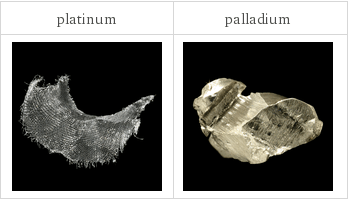
Images
Basic elemental properties
![| platinum | palladium atomic symbol | Pt | Pd atomic number | 78 | 46 short electronic configuration | [Xe]6s^14f^145d^9 | [Kr]4d^10 Aufbau diagram | 5d 4f 6s | 4d block | d | d group | 10 | 10 period | 6 | 5 atomic mass | 195.084 u | 106.42 u half-life | (stable) | (stable)](../image_source/eefb2b8e016e22be0c1c629b9a39503f.png)
| platinum | palladium atomic symbol | Pt | Pd atomic number | 78 | 46 short electronic configuration | [Xe]6s^14f^145d^9 | [Kr]4d^10 Aufbau diagram | 5d 4f 6s | 4d block | d | d group | 10 | 10 period | 6 | 5 atomic mass | 195.084 u | 106.42 u half-life | (stable) | (stable)
Thermodynamic properties
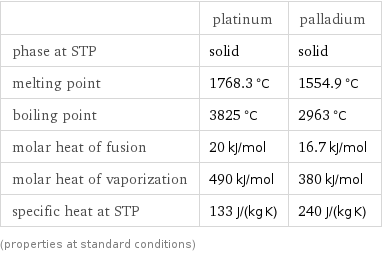
| platinum | palladium phase at STP | solid | solid melting point | 1768.3 °C | 1554.9 °C boiling point | 3825 °C | 2963 °C molar heat of fusion | 20 kJ/mol | 16.7 kJ/mol molar heat of vaporization | 490 kJ/mol | 380 kJ/mol specific heat at STP | 133 J/(kg K) | 240 J/(kg K) (properties at standard conditions)
Material properties
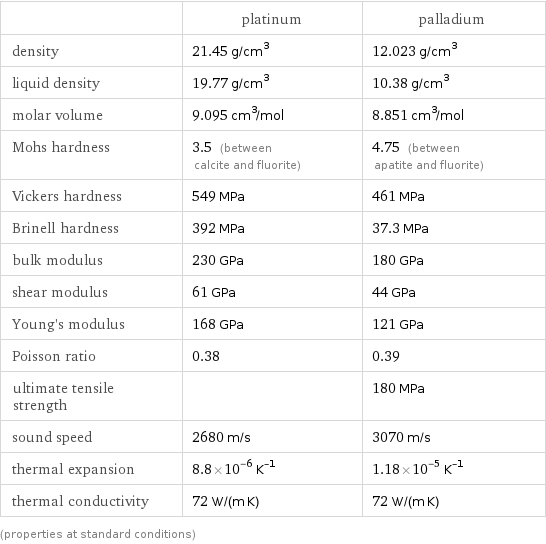
| platinum | palladium density | 21.45 g/cm^3 | 12.023 g/cm^3 liquid density | 19.77 g/cm^3 | 10.38 g/cm^3 molar volume | 9.095 cm^3/mol | 8.851 cm^3/mol Mohs hardness | 3.5 (between calcite and fluorite) | 4.75 (between apatite and fluorite) Vickers hardness | 549 MPa | 461 MPa Brinell hardness | 392 MPa | 37.3 MPa bulk modulus | 230 GPa | 180 GPa shear modulus | 61 GPa | 44 GPa Young's modulus | 168 GPa | 121 GPa Poisson ratio | 0.38 | 0.39 ultimate tensile strength | | 180 MPa sound speed | 2680 m/s | 3070 m/s thermal expansion | 8.8×10^-6 K^(-1) | 1.18×10^-5 K^(-1) thermal conductivity | 72 W/(m K) | 72 W/(m K) (properties at standard conditions)
Electromagnetic properties
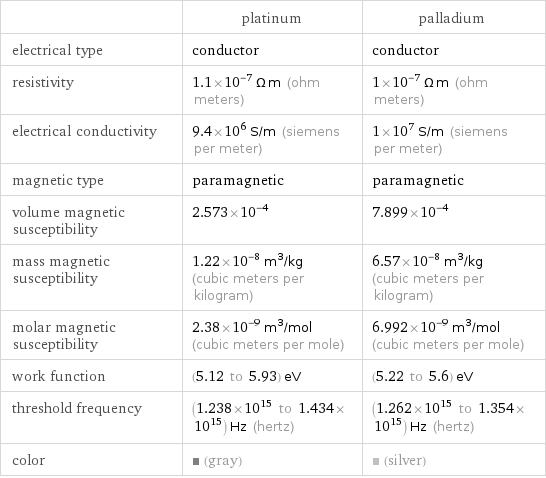
| platinum | palladium electrical type | conductor | conductor resistivity | 1.1×10^-7 Ω m (ohm meters) | 1×10^-7 Ω m (ohm meters) electrical conductivity | 9.4×10^6 S/m (siemens per meter) | 1×10^7 S/m (siemens per meter) magnetic type | paramagnetic | paramagnetic volume magnetic susceptibility | 2.573×10^-4 | 7.899×10^-4 mass magnetic susceptibility | 1.22×10^-8 m^3/kg (cubic meters per kilogram) | 6.57×10^-8 m^3/kg (cubic meters per kilogram) molar magnetic susceptibility | 2.38×10^-9 m^3/mol (cubic meters per mole) | 6.992×10^-9 m^3/mol (cubic meters per mole) work function | (5.12 to 5.93) eV | (5.22 to 5.6) eV threshold frequency | (1.238×10^15 to 1.434×10^15) Hz (hertz) | (1.262×10^15 to 1.354×10^15) Hz (hertz) color | (gray) | (silver)
Reactivity
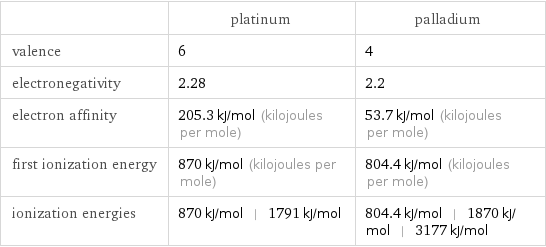
| platinum | palladium valence | 6 | 4 electronegativity | 2.28 | 2.2 electron affinity | 205.3 kJ/mol (kilojoules per mole) | 53.7 kJ/mol (kilojoules per mole) first ionization energy | 870 kJ/mol (kilojoules per mole) | 804.4 kJ/mol (kilojoules per mole) ionization energies | 870 kJ/mol | 1791 kJ/mol | 804.4 kJ/mol | 1870 kJ/mol | 3177 kJ/mol

Reactivity
Atomic properties
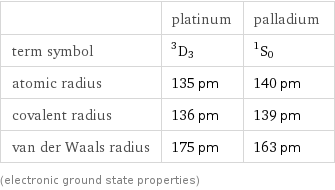
| platinum | palladium term symbol | ^3D_3 | ^1S_0 atomic radius | 135 pm | 140 pm covalent radius | 136 pm | 139 pm van der Waals radius | 175 pm | 163 pm (electronic ground state properties)
Abundances
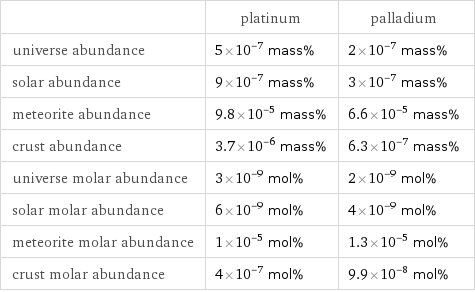
| platinum | palladium universe abundance | 5×10^-7 mass% | 2×10^-7 mass% solar abundance | 9×10^-7 mass% | 3×10^-7 mass% meteorite abundance | 9.8×10^-5 mass% | 6.6×10^-5 mass% crust abundance | 3.7×10^-6 mass% | 6.3×10^-7 mass% universe molar abundance | 3×10^-9 mol% | 2×10^-9 mol% solar molar abundance | 6×10^-9 mol% | 4×10^-9 mol% meteorite molar abundance | 1×10^-5 mol% | 1.3×10^-5 mol% crust molar abundance | 4×10^-7 mol% | 9.9×10^-8 mol%
Nuclear properties

| platinum | palladium half-life | (stable) | (stable) stable isotopes | Pt-195 (33.832%) | Pt-194 (32.967%) | Pt-196 (25.242%) | Pt-198 (7.163%) | Pt-192 (0.782%) | Pd-106 (27.33%) | Pd-108 (26.46%) | Pd-105 (22.33%) | Pd-110 (11.72%) | Pd-104 (11.14%) | Pd-102 (1.02%) nuclear spin | Pt-166: 0^+ | Pt-167: 7/2^- | Pt-168: 0^+ | Pt-169: 7/2^- | Pt-170: 0^+ | Pt-171: 3/2^- | Pt-172: 0^+ | Pt-173: 5/2^- | Pt-174: 0^+ | Pt-175: 7/2^- | Pt-176: 0^+ | Pt-177: 5/2^- | Pt-178: 0^+ | Pt-179: 1/2^- | Pt-180: 0^+ | Pt-181: 1/2^- | Pt-182: 0^+ | Pt-183: 1/2^- | Pt-184: 0^+ | Pt-185: 9/2^+ | Pt-186: 0^+ | Pt-187: 3/2^- | Pt-188: 0^+ | Pt-189: 3/2^- | Pt-190: 0^+ | Pt-191: 3/2^- | Pt-192: 0^+ | Pt-193: 1/2^- | Pt-194: 0^+ | Pt-195: 1/2^- | Pt-196: 0^+ | Pt-197: 1/2^- | Pt-198: 0^+ | Pt-199: 5/2^- | Pt-200: 0^+ | Pt-201: 5/2^- | Pt-202: 0^+ | Pd-91: 7/2^+ | Pd-92: 0^+ | Pd-94: 0^+ | Pd-95: 9/2^+ | Pd-96: 0^+ | Pd-97: 5/2^+ | Pd-98: 0^+ | Pd-99: 5/2^+ | Pd-100: 0^+ | Pd-101: 5/2^+ | Pd-102: 0^+ | Pd-103: 5/2^+ | Pd-104: 0^+ | Pd-105: 5/2^+ | Pd-106: 0^+ | Pd-107: 5/2^+ | Pd-108: 0^+ | Pd-109: 5/2^+ | Pd-110: 0^+ | Pd-111: 5/2^+ | Pd-112: 0^+ | Pd-113: 5/2^+ | Pd-114: 0^+ | Pd-115: 5/2^+ | Pd-116: 0^+ | Pd-117: 5/2^+ | Pd-118: 0^+ | Pd-120: 0^+ | Pd-122: 0^+ | Pd-124: 0^+ unstable isotopes | Pt-190 (650 billion yr) | Pt-193 (51 yr) | Pt-188 (10.2 days) | Pt-191 (67.9 h) | Pt-202 (44 h) | Pt-197 (19.8915 h) | Pt-200 (12 h) | Pt-189 (10.869 h) | Pt-187 (141 min) | Pt-186 (124.8 min) | Pt-185 (70.83 min) | Pt-199 (30.8 min) | Pt-184 (17.33 min) | Pt-183 (6.5 min) | Pt-182 (180 s) | Pt-201 (150 s) | Pt-180 (56 s) | Pt-181 (52 s) | Pt-179 (21.2 s) | Pt-178 (21.1 s) | Pt-177 (10.6 s) | Pt-176 (6.33 s) | Pt-175 (2.53 s) | Pt-174 (889 ms) | Pt-173 (382 ms) | Pt-172 (96 ms) | Pt-171 (51 ms) | Pt-170 (13.8 ms) | Pt-169 (7 ms) | Pt-168 (2.1 ms) | Pt-167 (900 µs) | Pt-166 (300 µs) | Pd-107 (6.5 Myr) | Pd-103 (16.99 days) | Pd-100 (87.2 h) | Pd-112 (21.031 h) | Pd-109 (13.7012 h) | Pd-101 (8.47 h) | Pd-111 (23 min) | Pd-99 (21.4 min) | Pd-98 (17.67 min) | Pd-97 (186 s) | Pd-114 (145 s) | Pd-96 (122 s) | Pd-113 (93 s) | Pd-115 (25 s) | Pd-116 (11.8 s) | Pd-95 (10 s) | Pd-94 (9 s) | Pd-117 (4.3 s) | Pd-118 (1.9 s) | Pd-93 (1.3 s) | Pd-119 (920 ms) | Pd-92 (700 ms) | Pd-120 (500 ms) | Pd-122 (175 ms) | Pd-123 (174 ms) | Pd-124 (38 ms) | Pd-91 (1 µs) | Pd-121 (150 ns) neutron cross-section | 10 b | 6.9 b neutron mass absorption | 0.002 m^2/kg | 0.0023 m^2/kg
Identifiers

| platinum | palladium CAS number | 7440-06-4 | 7440-05-3 PubChem CID number | 23939 | 23938